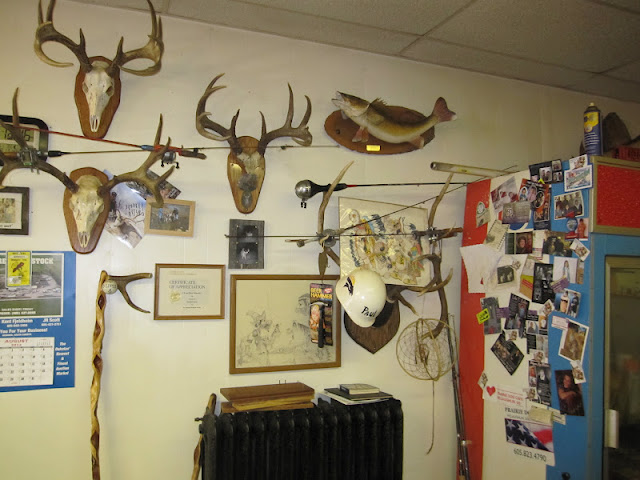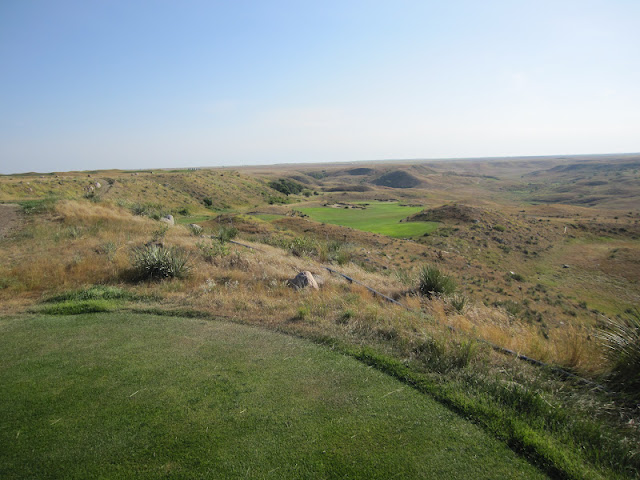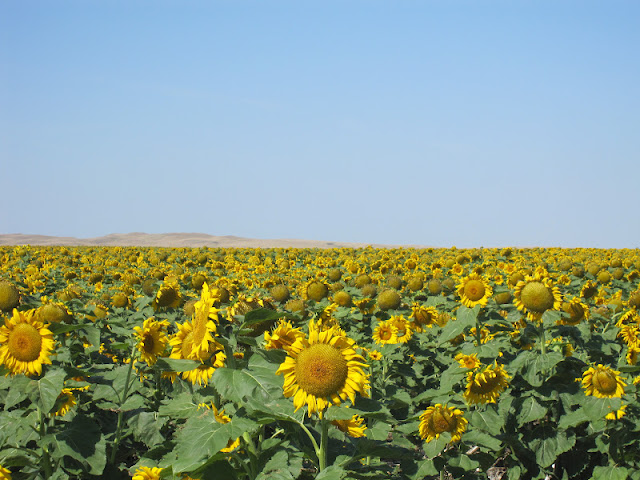We canceled our hotel reservation in Bismarck and drove 75-miles south where we took a room at the Prairie Knights Hotel & Casino located on the Standing Rock Indian Reservation. The evening drive provided great views of Lake Oahe from high bluffs above the water. We had to stop at one point while a rafter of wild turkeys crossed the road. The hotel room worked out to be the same cost as a room in Bismarck, after adding an appropriate donation to the one-armed bandit (slot machine for you non-gamblers!).
The next morning’s drive into South Dakota took us past herds of grazing buffalo immediately after crossing over the state line. A late start on the drive also meant we were looking for lunch on a road with very few towns and even fewer diners. Keeping in mind that travel is as much about the journey as it is the destination, we opted to stop in McLaughlin for a meal. We just could not pass up an opportunity to dine at the Prairie Dog Cafe on Main Street. On what other street would one look for a fine dining establishment in a town of 658 people? We did opt to pass on ordering the gizzards as an appetizer. I opted for the chicken fried steak special with mashed potatoes while Julie went with a Prairie Dog Mound from the breakfast menu. Business was brisk and the staff was limited so the service was not lightening quick. The food was good and the ambiance was even better.
Buffalo herd grazing in the grassland
Prairie Dog Cafe
A sample of the ambiance at the Prairie Dog Cafe
You need big lures to catch big fish!
The next stop after lunch was at the burial site of Sitting Bull situated on a bluff overlooking Lake Oahe, across the water from the town of Mobridge. Sitting Bull was a Lakota Sioux holy man who led his people as a tribal chief during years of resistance to United States government policies. He had a premonition of defeating the cavalry, which motivated his Native American people to a major victory at the Battle of the Little Bighorn against Lt. Col. George Custer in 1876. Months after the battle, Sitting Bull and his group fled into Canada. He returned to the United States in 1881 and surrendered to U.S. forces. Sitting Bull briefly toured as a performer in Buffalo Bill's Wild West Show, earning $50 a week. He was killed by Indian agency police during an attempt to arrest him in 1890.
Siting Bull monument
Sitting Bull's headstone
Gifts & tokens left at Sitting Bull's monument
Adjacent to Sitting Bull’s burial site is a memorial to Sakakawea. Since we were traveling down roads that ran parallel to the Missouri River, we observed numerous signs indicating that we were on the Lewis & Clark trail. Reading the inscription on Sakakawea’s monument was both interesting and timely. It read as follows:
Sakakawea won her place in history as the indomitable guide of Lewis & Clark on their trip to the Pacific in 1805. She was a member of the Shoshoni tribe dwelling near the Big Horn mountains in Montana. In one of the frequent tribal conflicts she was captured and taken to North Dakota as a war captive. Here she was purchased by a fur trader named Tousant Charbonneau who according to custom, made her his wife. Lewis & Clark, in search of an interpreter for their trip west, tried to hire Charbonneau, but he would not go unless his wife was permitted to accompany him. The explorers reluctantly gave their permission. This was a fortunate decision for Lewis & Clark. By her courage, endurance and unerring instinct she guided the expedition over seemingly insuperable obstacles. The leaders frequently gave her credit for the success of the venture. After returning east, Charbonneau and Sakakawea settled down at Fort Manuel near Kenel, South Dakota. On December 20, 1812 it was recorded in the daily journal of events at the fort that Sakakawea died of a putrid fever. There is no further record of her, but it is safe to assume that this remarkable woman’s grave is somewhere near the site of old Fort Manuel. Sakakawea is beyond question the most illustrious representative of the Indian race
Sakakawea's monument
Enough of the tourist information. Our purpose in traveling into South Dakota was golf. Our destination was perhaps the most remote location we have traveled to thus far. We arrived at the Sutton Bay Golf Club after traveling west off of Highway 83 through 15-miles of grassland and farm fields. There were no signs on habitation.
The obvious question would be who would ever build a golf course in such a remote location, and how could they afford to operate it? Sutton Bay is a private club with membership capped at 230 (they have turned down recent requests for membership). The remote location enables the club to serve as a destination for golf, hunting and fishing. Members can fly into local airports where the staff will meet their arrival and transport them back to the club’s property. We received a taste of their excellent service as we were greeted upon arrival by two staff members, one of whom was the club’s PGA pro. That was a first for me!
Club house & putting green
Club house entry way
Lounge
Billiard & card room
2nd floor hallway
Guest rooms
Hunting at Sutton Bay encompasses close to 10,000 acres of land: 1,000 acres owned by the club, 3,600 acres of licensed preserve, and 5,000 acres of leased land. Experienced guides with trained dogs are provided. In addition to plentiful deer and pheasants, the club’s location on the central flyway provides excellent hunting for Canadian geese. Lake Oahe is also a premier walleye lake. Professional guides, complete with all the needed fishing gear, are ready to escort members on fishing expeditions for walleye, bass, northern pike and Chinook salmon.
"Passing the buck" on the golf course
Wine flavored pheasant???
Did I mention they have a golf course as well? Designed by Graham Marsh, the golf course is carved out of dramatic landforms along the Missouri river. The site resembles the terrain one may find on some of the finest courses in the British Isles. While not a true links course, it has all the characteristics associated with links courses: spectacular elevation changes with natural green sites and fairways nestled amongst prairie grasses, rock forms and rolling terrain.
It was becoming clear to me that I would be playing golf on the rich men’s playground - - - and that was OK by me! After all, Sutton Bay is the #1 rated course in South Dakota by Golf Digest and the 85th top rated course in the United States by Golf Magazine. I was happy they allowed me to play the course. I did elect to warm-up by playing the 9-hole par 3 course on the evening of my arrival.
Overview of the 9-hole par 3 course
181-yard par 3 hole #2
147-yard par 3 hole #3
146-yard par 3 hole #7
Round: #45
Location: Agar, SD
Golf Digest Best-In-State Rank: #1
Date: 14 Aug, tee off at 7:45 AM
Conditions: cloudy, 18 MPH wind, 64 degrees
Yardage: 6,503
Lost balls: 0
Score: 82 on a par 72
One of the requirements for me to play at Sutton Bay was to utilize a fore caddy on the round. It worked out quite well for a number of reasons. First, I teed off as a single player so the fore caddy provided companionship on the round. Second, the course was undergoing a dramatic re-design which meant it was in a state of flux with very little signage. The fore caddy helped to act as a guide as we moved around the course. Third, the caddy assigned to accompany me had played college golf so he knew how to advise me on playing distances and in reading the greens. Any caddy can use a scope to provide a distance to the green; my caddy was able to factor in wind and landing zones to provide me with great advice on shot selection.
Chris Slaton has been a fore caddy at Sutton Bay for 3-months. He moved to Gettysburg, South Dakota from California after accepting the job at Sutton Bay. Originally from Battleground, Washington he has lived in multiple states; his previous job was caddying in Palm Springs, California. Chris has an older sister who currently resides in California. He has been working through the PGA program to become a Class A professional. The program requires attendance at multiple week-long clinics in Florida, assignments that can be completed remotely, and golf experience. Chris is within 1-year of completing the program if he remains diligent. He commutes to work 30-miles one-way from his residence in the small town of Gettysburg (population 1,179).
Fore caddy Chris Slaton
I dressed in long slacks and put on a light jacket before leaving the clubhouse. The outside temperature was 62 degrees at 7:15 AM when we arrived at an empty practice range. The sky threatened a morning shower; the wind made it a chilly start for golf. I began to wonder if I had made a mistake by not playing the previous day when the weather was warm and sunny. I did not need to wonder for long as the sky started to clear by the time I began play. It turned out to be a beautiful day - - - in more ways than one.
Buffalo skulls used to mark the tee boxes
From the moment I stepped onto the practice range I could tell the golf gods were on my side today. My drives were straight at whatever target Chris told me to hit. Approach shots hit the landing zones he pointed out. My putter was red hot; several long putts narrowly slipped by the hole before stopping within a foot or two of the cup for easy tap-in pars. What a great day for golf.
353-yard par 4 hole #2
Hole #2 (view of approach shot from the fairway)
I was playing the front nine down wind, reaching the greens in regulation. A short 6’ putt dropped for a birdie on hole #3. The strong wind propelled my ball to 3’ in front of the green on the short par 4 hole #4. The 60’ eagle putt rolled within inches of dropping before rolling off downhill, after a 2-putt uphill I finished with a par. I went even par for the first 6-holes with one birdie and one bogey on the card. At one point Chris said he would start pointing out the blade of grass he wanted me to hit because my driver was in the zone.
541-yard par 5 hole #3
Hole #3 (view of approach shot from the fairway)
283-yard par 4 hole #4
Hole #4 (view of the eagle putt)
After watching my shots, Chris advised me to use a driver on the par 3 hole #7. With an uphill shot into the wind his guidance allowed me to land a ball on the green. My putter let me down as I 3-putted the hole for my second bogey. Nothing can last forever - I finished the front nine with a triple bogey-bogey to shoot a respectable 41 on the front.
211-yard par 3 hole #7
The back nine started out with 4-straight bogeys. I returned to the zone with a par on the 14th hole, but fell back with a double bogey on the 15th hole after missing my iron shots. On hole #16 I chipped an approach shot to the green from 40‘ out and dropped the putt for another birdie. Two pars finished the back nine with score of 41 on the card.
399-yard par 4 hole #11
151-yard par 3 hole #14
508-yard par 5 hole #16
165-yard par 3 hole #17
I mentioned above that the golf course was in a state of flux. In the short period of time since the course opened for play in 2003, dramatic shifts in the terrain resulted in the club’s decision to rebuild the course. The hillside was collapsing toward the lake’s shoreline causing over 200 breaks in the irrigation lines each year. Moving the course to more stable ground at the cost of $3-4 million would provide a permanent solution. The front 9-holes I played were the newly designed course while the back 9-holes were a mixture of holes from the old course.
Ground depressions on hole #10 fairway
Shifting terrain in the native grass hillside
The "old" abandoned hole #16
The "old" abandoned hole #17 (green is in the foreground)
Our departure from Sutton Bay took us past herds of antelope and fields of sunflowers on the road from South Dakota into Nebraska.
Herd of antelope









































No comments:
Post a Comment